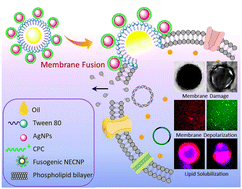A membrane targeted multifunctional cationic nanoparticle conjugated fusogenic nanoemulsion (CFusoN): induced membrane depolarization and lipid solubilization to accelerate the killing of Staphylococcus aureus†
Abstract
Bacterial infections caused by Staphylococcus aureus are one of the growing concerns for human health care management globally. Antibiotic-associated adverse effects and the emergence of bacterial resistant strains necessitate the development of an alternative yet effective approach. Nanoemulsion-based therapy has emerged as a potential therapeutic strategy to combat bacterial infestation. Herein, we designed a cationic metal nanoparticle-conjugated fusogenic nanoemulsion (CFusoN) as a lipid solubilizing nanovesicle for the effective treatment of S. aureus infection with a killing efficiency of 99.999%. The cationic nanoparticle-conjugated nanoemulsion (viz. NECNP) (24.4 ± 2.9 mV) electrostatically bound with the negatively charged bacterial cell membrane (−10.2 ± 3.7 mV) causing alteration of the bacterial surface charge. The fluorometric and flow cytometry studies confirmed the bacterial membrane depolarization and altered cell membrane permeability leading to cell death. The atomic force microscopic studies further demonstrated the damage of the cellular ultrastructure, while the transmission electron microscopic image and membrane lipid solubilization analysis depicted the solubilization of the bacterial membrane lipid bilayer along with the leakage of the intracellular contents. The cell membrane fatty acid analysis revealed that the methyl esters of palmitic acid, stearic acid and octadecadienoic acid isomers were solubilized after the treatment of S. aureus with CFusoN. The bactericidal killing efficiency of CFusoN is proposed to occur through the synergistic efficacy of the targeted attachment of CNP to the bacterial cells along with the lipid solubilization property of NE. Interestingly, NECNP didn’t elicit any in vitro hemolytic activity or cytotoxicity against red blood cells (RBCs) and L929 fibroblast cells, respectively, at its bactericidal concentration. Furthermore, a porcine skin wound infection model exhibited the enhanced wound cleansing potency of CFusoN in comparison to the commercially available wound cleansers. The obtained antibacterial activity, biocompatibility and skin wound disinfection efficacy of the NECNP demonstrated the formulation of a cell targeted CFusoN as a promising translatable strategy to combat bacterial infection.

- This article is part of the themed collections: Celebrating the scientific accomplishments of RSC Fellows and #MyFirstMH


 Please wait while we load your content...
Please wait while we load your content...